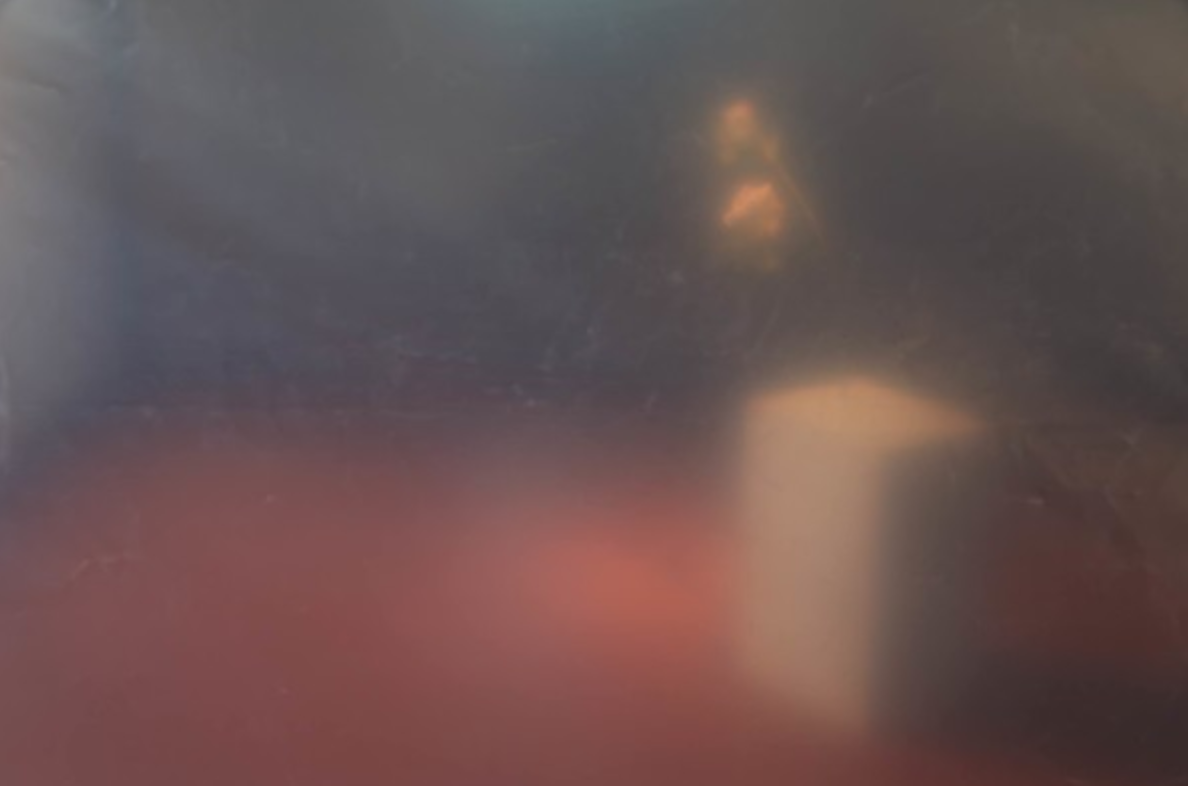Giulia Poppi (b. 1992) is a visual artist based in Bologna. Her work, brazenly hot and material, is imbued with symbolic references that relate to intimacy and mystery. Poppi employs synthetic materials and artificial light to create a plurality of images. These images along with various objects and sketches of artefacts, are orchestrated in complex environments in order to generate bodily and tactile sensations. The physicality of the works often requires the viewer to reinterpret the character and the very experience of being in a given space which consequently triggers mechanisms of attraction and repulsion.
In 2016, Poppi founded Malgrado, an art space in Bologna where she curated events along with two colleagues. Her most important exhibitions include: P420, Bologna (2016, 2018), Mambo, Bologna (2017), Localedue, Torino (2017), Biennale dei Giovani, Monza (2017), Gelateria Sogni di Ghiaccio, Bologna (2019), CampoBase, Torino (2019), CarDrde, Bologna (2019), Manifattura Tabacchi, Firenze (2020), Museo Michetti, Francavilla (2020) and Pinacoteca Nazionale, Bologna (2020). In 2018, collaborating with Illy, Poppi designed the graphics for their coffee tin labels. In 2019, she won the ArtUp collectors prize (Bologna), she was artist in residence at Manifattura Tabacchi (Florence) and she is among the ten winners of AccadeMibact, exhibiting in Domani Qui Oggi, curated by Ilaria Gianni, the main collateral event of Art Quadriennal 2020 (Rome).
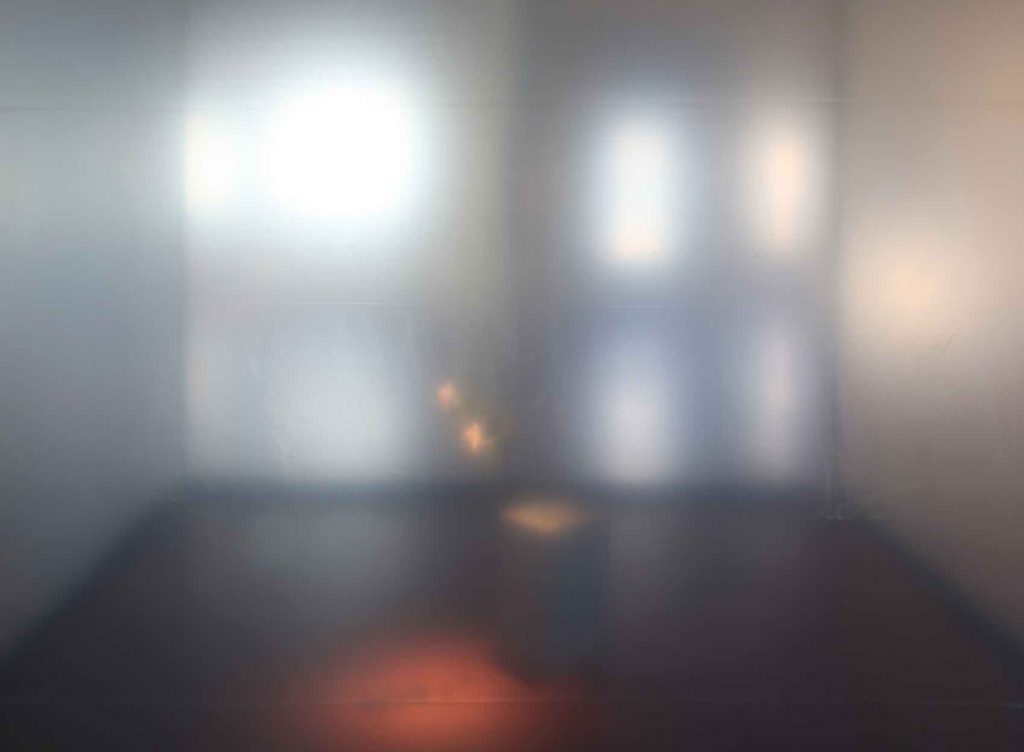
Ginevra Ludovici: How would you describe your artistic practice? Where does your research come from?
Giulia Poppi: My practice has to do with a close relationship between objects and their materiality. I am interested in seeing how we interact with what surrounds us and the materials represent an important filter for me, they are the point of contact that exists between our bodily being and the surrounding external to us. The suggestions that nourish my practice are among the most disparate: they often come from nature, where I happen to observe things that apparently seem more artificial than they actually are. Right now, for example, I have an orchid in front of me, its structure would seem to be the result of a modern 3D computer graphics processing unit, its texture recalls latex or the typical textures of simulated materials with perfect colors and also acids whose reflections of light seem to be the result of a digital calculation, while instead it is all absolutely natural.
I like to play with materials, ranging between reality and sophistication to convey a certain underlying ambiguity. My interest intends to investigate the paradoxes of the perception of reality, how much they are influencing and being influenced by the observer’s mental experience. The first real guinea pig in the game is somehow myself. To do this, it is necessary that the works and the observer have a complete sensory interaction, they must be able to be touched, heard and perceived with means beyond the visual; The essence of the works themselves is precisely contained in this aspect. The works invade the spaces, they impose themselves, they clutter, they invite contact, they open and close passages, they obscure and cloud the view, they generate noises, in short, they force us to deal with their presence. They disguise themselves with an illusory consistency where the movement of a drapery hides a glassy rigidity and the imposing mass of a wall conceals a soft fabric imbued with light behind its hostile features.
As a child I was convinced that the moquette in my room was responsible for the disappearance of my toys, sucking them up and dropping them on another floor, like a soft and viscous lava that swallowed them. With the same force with which we then believed that everything that could be real, today we avoid these “illusions” by considering them a sub-category of reality and granting them as a consolation prize some metaphorical or symbolic value passed through the censorship of reason. Instead, I like the idea of keeping this perceptual plasticity free, keeping multiple planes open at the same time. I think there is something mystical about the interaction with matter, the mind is left aside for a moment, it freezes, it cannot interpret, the separation is canceled, there is no time around a sensory stimulus, for a moment this absurd and childish vision that we insist on calling “objective reality” fails.
A practical example to better clarify this concept is the work Glassblock, exhibited at CAR DRDE gallery, which consists of a cold, hard, apparently immovable concrete glass wall. This is the image, the first thing you perceive. Then when you approach the work, due to the shape of the space in which it is inserted, it is necessary to move this wall, which is suddenly yielding, imbued with light, pleasant to the touch, it evokes a pleasant, erotic experience.
At the same time, the wall carries with it references to Gothic architecture, somehow recalling a stained glass window in a cathedral that divides the shadow of the place of worship from the sunlight, only allowing the light to pass through a filter.
The wall is, therefore, intended as a pretext for a sensory experience that pushes us to change perspective.
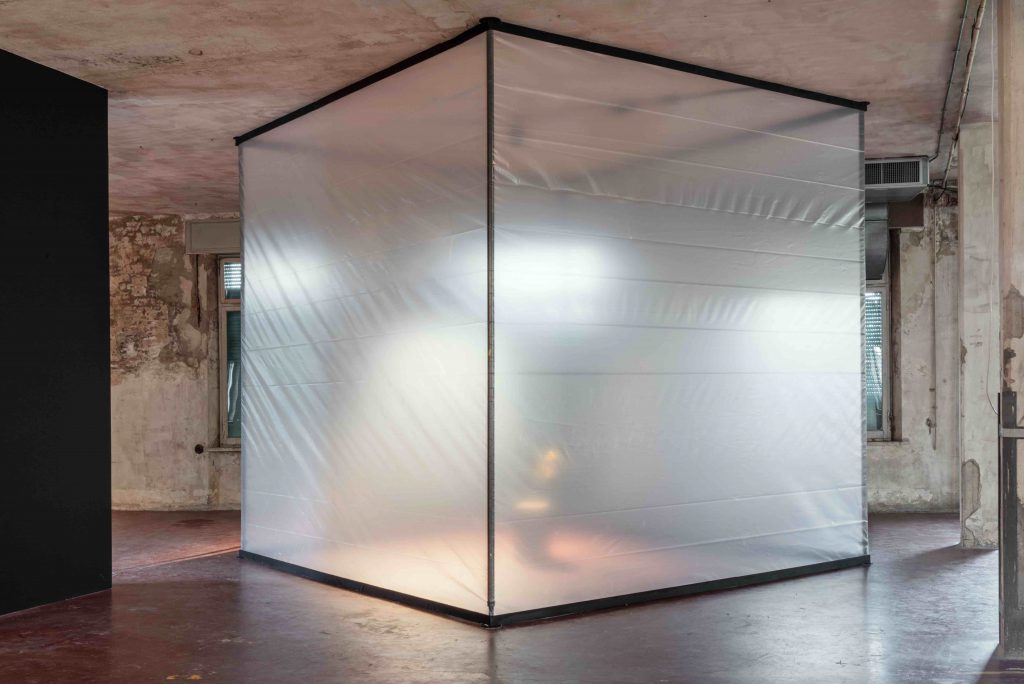
Installation view at La Meraviglia, curated by Sergio Risaliti. Manifattura Tabacchi, Firenze. Photo Leonardo Morfini
G.L In recent years you have lived in Bologna, where you trained at the Academy of Fine Arts. How has your relationship with the city influenced your work?
G.P. Bologna is a city on a human scale, that I really appreciate and that facilitates relationships with other people. In recent years there have been many realities that have coexisted in the Bolognese system, sustained by the work of institutions but also by the dense activity of project-spaces, such as Tripla, Localedue, Porto dell’Arte, Gelateria Sogni di Ghiaccio, which have been an important context of experimentation and growth for all of us, in GSG for example I had the opportunity to confront myself with my first solo show, Sbranksbunkdum. Among the various realities, collaborations of professional nature have been created spontaneously, based on informality, reciprocity and the desire for exchange and dialogue. The Academy was an important crossroads, from there I began to build many of the collaborations that accompany me to date.
G.L. In 2015, you spent an Erasmus period at the Akademie der Bildenden Kunst in Munich. What was it like dealing with the German educational system?
G.P. The experience in Munich was an important moment in my path and fundamental for my maturation. The Academy offers every possible technical means, that is, staff and laboratories with a high professional level to create any type of work. The work spaces, open 24 hours a day, were a considerable infrastructural support. Furthermore, it was possible to freely range between various expressive languages and there was no clear division on the possibilities of experimentation.
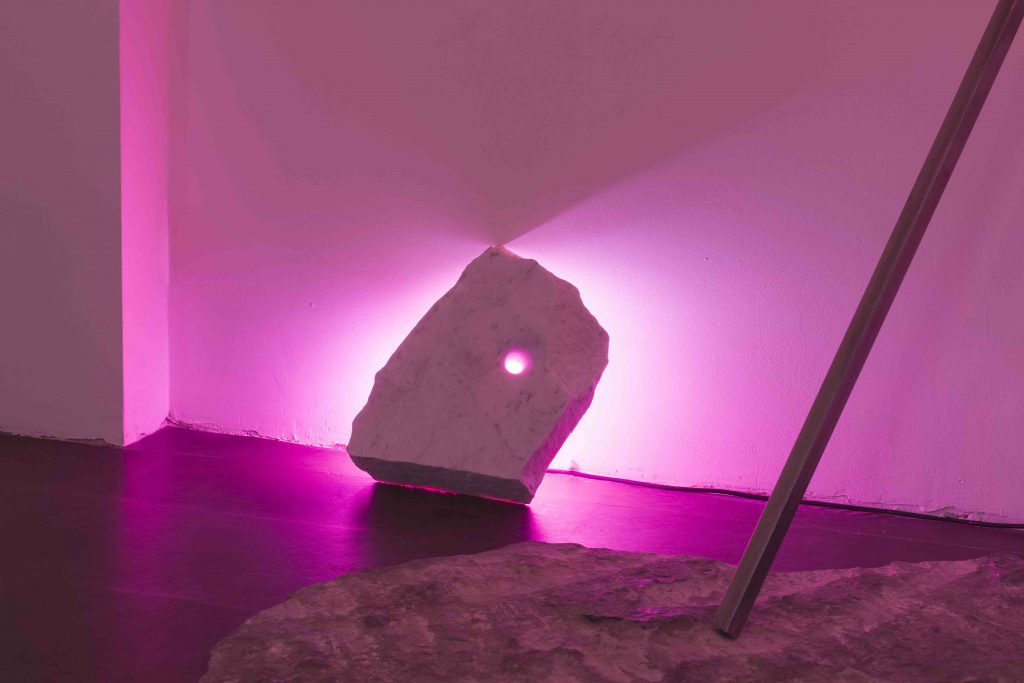
Photo Studio Abruzzese
G.L. You were one of the founders of the Malgrado space- project, which operated in Bologna in 2016-2017. Would you tell us more?
G.P. The project was born with Lucia Fontanelli whom I met in Bologna for an exhibition with Cuoghi Corsello and with whom I then spent a period of residency at the Lac or Le Mon Foundation. From this meeting was born the desire to share a studio that took shape in a space near vicolo Malgrado, hence the name. The intention was to have a simple workshop and only at a later time did the idea of starting a cycle of exhibitions tickle us, at that moment Dina Loudmer joined us.
Our format was quite simple: every Tuesday we had an impromptu inauguration. So the exhibition ended over the course of an evening. There was no communication of the event, except through word of mouth and some flyers on Whatsapp with which we started the rumors. We liked the idea of experimenting with a certain lightness following a sort of situationist logic. In a short time the space became a meeting point, where each time we proposed different events, including exhibitions, performances and concerts. We often created hybrids between the various languages, so we built a kind of basic scenography within which different things could happen thanks to the interaction with our audience who became an active participant. At the basis of the project there was the desire to collaborate and have fun. The whole process was based on trust and on a certain underlying permeability, so people were passing by Malgrado, everyone had their say and shuffled the cards in play, hybridizing the display we had set up. The exhibition environment therefore was every time reconfigured and reshaped and it was especially suitable for being inhabited. A space in which to materialize somewhat crazy things that you might not have ventured in other contexts and spontaneously, due to the transience, the playful atmosphere, the tight programming, we found ourselves with an appointment that actually brought together a beautiful and heterogeneous community.
Then we got involved with Localedue during the NEXST festival. Localedue invited us to inhabit its space during the Turin event and on that occasion we gave shape to MedusaMedusaMedusa. Afterwards, Malgrado has been involved in the BBQ project during Bologna Artefiera for the realization of an exhibition event. The event took place in the house where I lived, in via Saragozza. The exhibition, entitled Malgrado S2: E1, was divided into two floors which were connected by the external courtyard. The artists who participated in this project were Melania Fusco, Sacha Kanah and Lisa Dalfino, Lori Lako and Luca Savić.
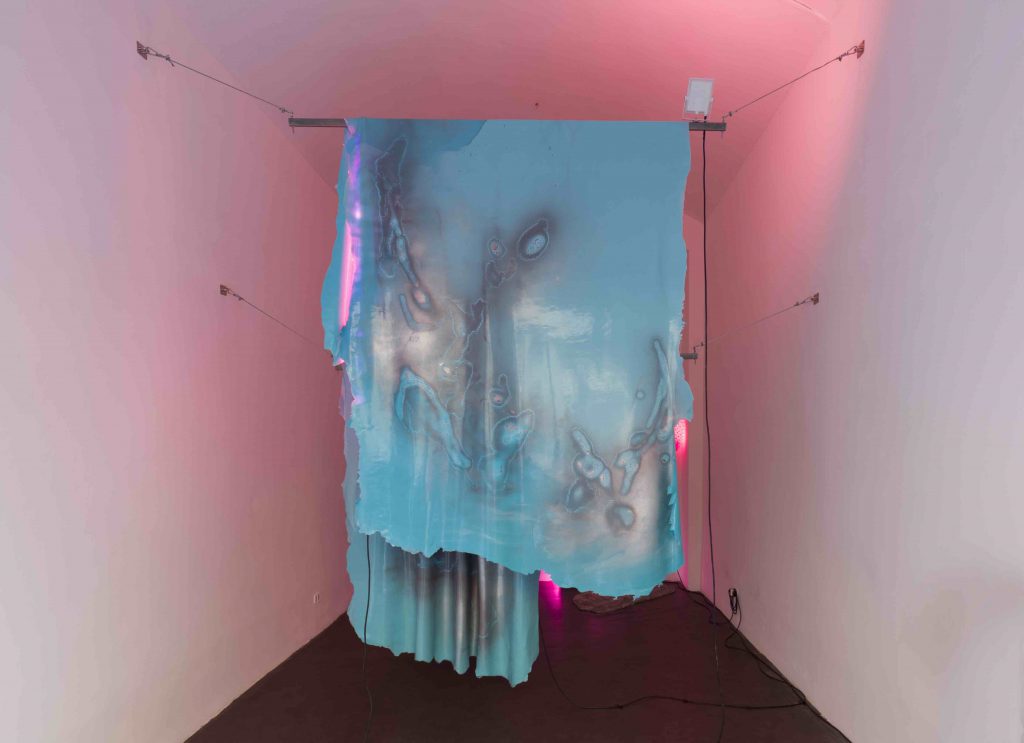
G.L. Last year you were selected for the artist residency program at Manifattura Tabacchi. How did the experience unfold and how did it help redefine your practice?
G.P. The residency in Florence lasted six months. The other participating artists and I had a studio, accommodation and in general the support system provided by Manifattura Tabacchi. There were six of us, all very different from each other, both in terms of training and in terms of research and languages, so the dialogue was very interesting. Then, the experience at the Manifattura was the first circumstance in which I was able to structure a project by coordinating it with several voices, being followed by a staff of technicians. I also believe that the confrontation with Sergio Risaliti and Paolo Parisi, tutor of the residency program, was a very nice opportunity to try out a new fabric of relationships, collaborations and dialogues.
G. L. In Florence you finalized the work Fantavergini Senza Paura, can you tell us how the project has evolved?
G.P. In Florence we had large industrial spaces within the former tobacco factory that were still being restored, a construction site in these large rooms with very high ceilings and long corridors. In this context I was making the resin castings that later became the first Caravelle – a series of works that I later exhibited in Francavilla in the context of the Michetti Award -, obviously dust and resins do not get along. To protect the work from dust I had traced a square perimeter with transparent greenhouse nylon sheets. The atmosphere and the situation of the place had become surreal, as if to do it on purpose at that time words such as isolation, quarantine and curfew began to circulate. Once my Caravelle were finished, I had to return to Modena in a hurry with a quantity of photographic material from those rather strange days of work. The rest came a little by itself. The rose and the stump were part of an image that occupied my mind previously and that I was unable to conceptualise in a final piece. In the period that I spent at home, away from everything and with all these images that fluttered in my head, things have rearranged themselves. The image had become quite clear. The mist envelops and flattens the object which becomes a perfect pretext. The frustrating inaccessibility leads to turning around these walls that offer a two-dimensional, almost cinematic image, which moves with the viewer and leads to explore its surface to understand its content in search of access. Natural and artificial lights merge, confusing their nature, the nylon cube carves out a portion of space, a solid of fog that removes the content from view and becomes a subject and image disturbance device.
At the center of the work, set in the casting of the concrete solid, there is an artificial rose. The object is, however, a pretext, the rose seemed perfect in this sense: it is a hyper-abused element, for this reason it is loaded with symbols and references that are stratified passing from kitsch to a more spiritual dimension, it is the rose of the Harmony novels, a fairy-tale element as in Belinda and the Monster, a mystical object that refers to the Christian iconographic tradition. I like that this ambiguity also returns in the title, Fantavergini Senza Paura, found in the pages of ABC, an Italian weekly from the 70s, a terrible stuff, a monstrous cross between Playboy and Cronaca Vera.
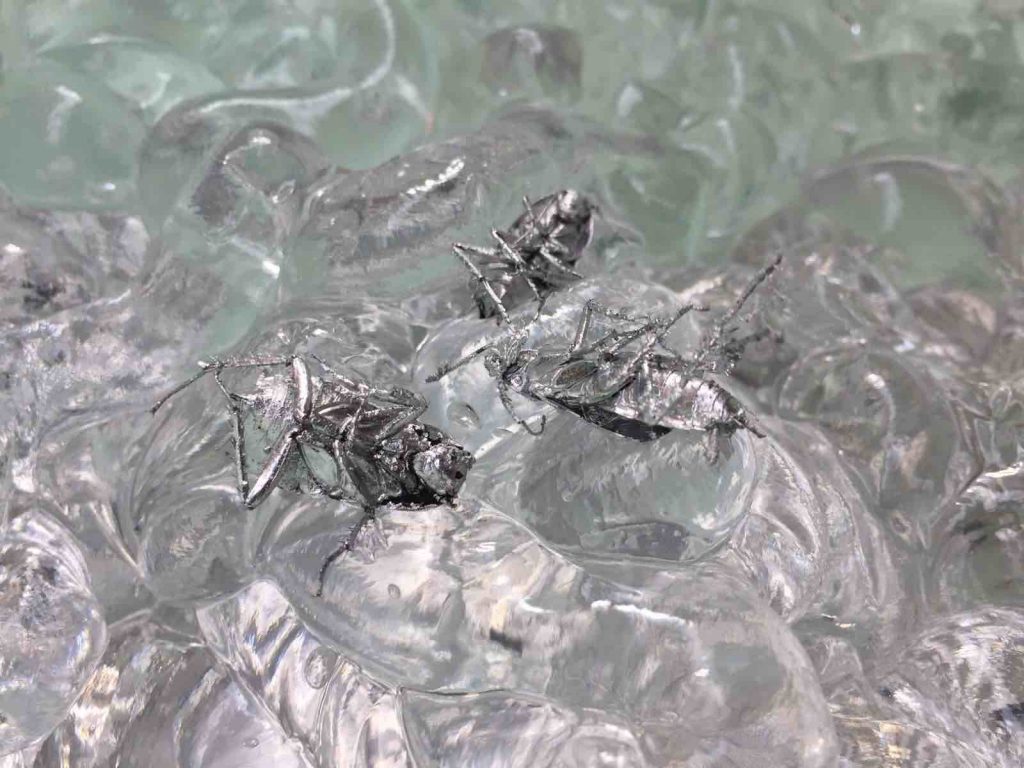
Plaster, reflective floor, spray paint, pigment, paraffin, ecographic gel, cockroaches
G.L. Currently your piece Passagatto is exhibited at the Palazzo delle Esposizioni, within the exhibition Domani Qui Oggi, which presents the work of ten emerging artists from the Academies of Fine Arts selected as part of the AccadeMibact Award. How did you relate to the exhibition space in the design and realization of a new work?
G.P. In Montemerano, a small town in Tuscany, there is a tempera on a wood altarpiece depicting a Madonna. The painting appears to be in excellent condition, if not for a strange detail next to the virgin’s feet. A diligent and imaginative sacristan, probably not finding anything better, adapted the painting to a much more practical use than usual. The altarpiece, once cut into the shape of a door and placed at the entrance to the cellar of the church, seemed perfect, only one problem remained: how to allow the parish priest’s cat to pass through to facilitate his role as a mouse hunter; it is easy to say, sawing a cat flap at the foot of a sacred painting of the fifteenth century. The cat flap is a transition element between inside and outside. It is usually placed on doors and has entered the common imagination as the protagonist of some of the cartoons that accompanied our childhood. The invention of the cat flap is attributed to Isaac Newton, who, between his tenure as president at the Royal Society of London and the development of the natural logarithm series for the calculation of pi, however, found the time to engineer this device.
Here we come to the cat flap proposed in an exhibition space such as that of the Palazzo delle Esposizioni, the tone remains facetious and recalls certain architectural distortions such as the cellar door of the Montemerano church, which are often seen only with the corner of the eye. Or like those paradoxical balconies with parapets but without doors to access them and those unfinished projects of freeways that end up in the middle of a plowed field.
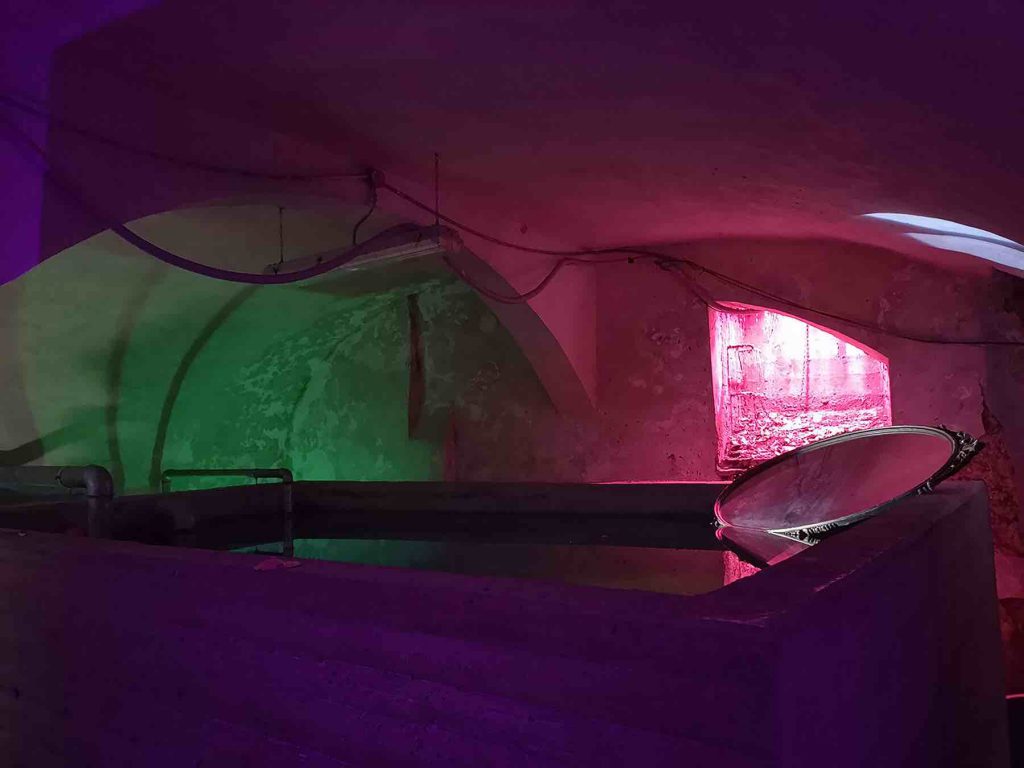
I like to work in close relation with space, to be able to connote and transform it, even in a barely perceptible way, as in this case. My attention was focused on one of the thresholds of the exhibition space, it has four different entrances arranged in a cross along its perimeter. I decided to wall one of these entrances with a plasterboard wall in which I inserted the cat flap, the anomaly is quite delicate, you can only notice it by carefully observing the architecture of the space and its symmetry. The cat flap, which through automation makes the overhead door swing, generates the hypothesis of the presence of a cat, or rather the latter exists in the mind of the observer, clashing with the likelihood of the exhibition context. I liked the idea of dematerializing this cat, this spirit or ghost that roams the exhibition. A phantom work for a phantom audience, the exhibition is actually set up at the moment but is closed.
G.L. How has your work changed during the pandemic?
G.P. In spite of myself, I was able to see that it moved. I began to think that my sculptures could contain a before, an after and a during. Getting the right moment gives you great satisfaction.


